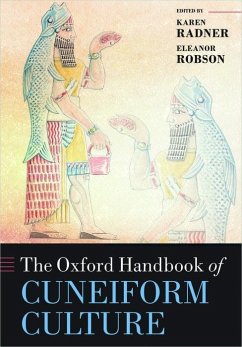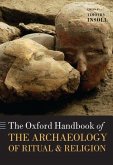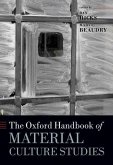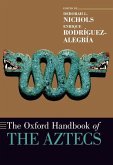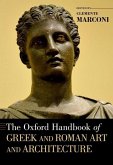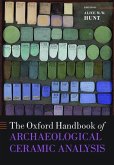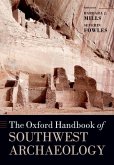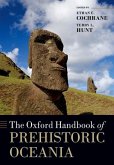The Oxford Handbook of Cuneiform Culture
Herausgeber: Radner, Karen; Robson, Eleanor
The Oxford Handbook of Cuneiform Culture
Herausgeber: Radner, Karen; Robson, Eleanor
- Broschiertes Buch
- Merkliste
- Auf die Merkliste
- Bewerten Bewerten
- Teilen
- Produkt teilen
- Produkterinnerung
- Produkterinnerung
An authoritative guide to the Ancient Middle East as seen through the lens of cuneiform writing, the writing system of ancient Mesopotamia. Written by a team of international scholars, with chapter bibliographies and numerous illustrations, the Handbook is a state-of-the-art guide to the discipline as well as offering pathways for future research.
Andere Kunden interessierten sich auch für
![The Oxford Handbook of the Archaeology of Ritual and Religion The Oxford Handbook of the Archaeology of Ritual and Religion]() The Oxford Handbook of the Archaeology of Ritual and Religion62,99 €
The Oxford Handbook of the Archaeology of Ritual and Religion62,99 €![The Oxford Handbook of Material Culture Studies The Oxford Handbook of Material Culture Studies]() The Oxford Handbook of Material Culture Studies62,99 €
The Oxford Handbook of Material Culture Studies62,99 €![The Oxford Handbook of the Aztecs The Oxford Handbook of the Aztecs]() The Oxford Handbook of the Aztecs70,99 €
The Oxford Handbook of the Aztecs70,99 €![Oxford Handbook of Greek and Roman Art and Architecture Oxford Handbook of Greek and Roman Art and Architecture]() Clemente MarconiOxford Handbook of Greek and Roman Art and Architecture77,99 €
Clemente MarconiOxford Handbook of Greek and Roman Art and Architecture77,99 €![Oxford Handbook of Archaeological Ceramic Analysis Oxford Handbook of Archaeological Ceramic Analysis]() Oxford Handbook of Archaeological Ceramic Analysis63,99 €
Oxford Handbook of Archaeological Ceramic Analysis63,99 €![The Oxford Handbook of Southwest Archaeology The Oxford Handbook of Southwest Archaeology]() Barbara J MillsThe Oxford Handbook of Southwest Archaeology77,99 €
Barbara J MillsThe Oxford Handbook of Southwest Archaeology77,99 €![Oxford Handbook of Prehistoric Oceania Oxford Handbook of Prehistoric Oceania]() Terry L HuntOxford Handbook of Prehistoric Oceania77,99 €
Terry L HuntOxford Handbook of Prehistoric Oceania77,99 €-
-
-
An authoritative guide to the Ancient Middle East as seen through the lens of cuneiform writing, the writing system of ancient Mesopotamia. Written by a team of international scholars, with chapter bibliographies and numerous illustrations, the Handbook is a state-of-the-art guide to the discipline as well as offering pathways for future research.
Hinweis: Dieser Artikel kann nur an eine deutsche Lieferadresse ausgeliefert werden.
Hinweis: Dieser Artikel kann nur an eine deutsche Lieferadresse ausgeliefert werden.
Produktdetails
- Produktdetails
- Verlag: Hurst & Co.
- Seitenzahl: 848
- Erscheinungstermin: 25. März 2020
- Englisch
- Abmessung: 248mm x 175mm x 42mm
- Gewicht: 1599g
- ISBN-13: 9780198856030
- ISBN-10: 0198856032
- Artikelnr.: 58408493
- Herstellerkennzeichnung
- Libri GmbH
- Europaallee 1
- 36244 Bad Hersfeld
- gpsr@libri.de
- Verlag: Hurst & Co.
- Seitenzahl: 848
- Erscheinungstermin: 25. März 2020
- Englisch
- Abmessung: 248mm x 175mm x 42mm
- Gewicht: 1599g
- ISBN-13: 9780198856030
- ISBN-10: 0198856032
- Artikelnr.: 58408493
- Herstellerkennzeichnung
- Libri GmbH
- Europaallee 1
- 36244 Bad Hersfeld
- gpsr@libri.de
Karen Radner (PhD Vienna 1997, Habilation Munich 2004) is the Alexander von Humboldt Professor for Ancient History of the Near and Middle East at LMU Munich. Her main research interests are in Assyria, especially the period from the 9th to the 7th centuries BC, on whose political, social, economic, legal, and religious history she has published extensively. Her books include editions of Middle and Neo-Assyrian archives and a study on how awareness of man's mortality shaped Mesopotamian culture (Die Macht des Namens: altorientalische Strategien zur Selbsterhaltung, 2005). She directs an AHRC-funded research project on the correspondence between the Assyrian kings and their magnates in the 8th century BC (http://www.ucl.ac.uk/sargon). Eleanor Robson is Professor of Ancient Middle Eastern History at University College London. Her research focuses on the socio-political contexts of intellectual activity in ancient Mesopotamia and the online edition of cuneiform texts. She is the author of Mathematics in Ancient Iraq: A Social History (2008) and director of the AHRC-funded research project, The Geography of Knowledge in Assyria and Babylonia, 700-200 BC (http://oracc.org/gkab).
* I. Materiality and literacies
* 1: Jonathan Taylor: Tablets as artefacts, scribes as artisans
* 2: Robert K. Englund: Accounting in proto-cuneiform
* 3: Grégory Chambon: Numeracy and metrology
* 4: Niek Veldhuis: Levels of literacy
* 5: Brigitte Lion: Literacy and gender
* II. Individuals and communities
* 6: Benjamin R. Foster: The person in Mesopotamian thought
* 7: Frans van Koppen: The scribe of the Flood Story and his circle
* 8: Hagan Brunke: Feasts for the living, the dead, and the gods
* 9: Michael Jursa: Cuneiform writing in Neo-Babylonian temple
communities
* 10: Eva von Dassow: Freedom in ancient Near Eastern societies
* III. Experts and novices
* 11: Yoram Cohen and Sivan Kedar: Teacher-student relationships: two
case studies
* 12: Dominique Charpin: Patron and client: Zimri-Lim and Asqudum the
diviner
* 13: Michel Tanret: Learned, rich, famous and unhappy: Ur-Utu of
Sippar
* 14: Nele Ziegler: Music, the work of professionals
* 15: Silvie Zamazalová: The education of Neo-Assyrian princes
* IV. Decisions
* 16: Sophie Démare-Lafont: Judicial decision-making: judges and
arbitrators
* 17: Karen Radner: Royal decision-making: kings, magnates and scholars
* 18: Andreas Fuchs: Assyria at war: strategy and conduct
* 19: Anne Löhnert: Manipulating the gods: lamenting in context
* 20: Daniel Schwemer: Magic rituals: conceptualisation and performance
* V. Interpretations
* 21: Ulla Susanne Koch: Sheep and sky: systems of divinatory
interpretation
* 22: John M. Steele: Making sense of time: observational and
theoretical calendars
* 23: Fabienne Huber Vulliet: Letters as correspondence, letters as
literature
* 24: Eckart Frahm: Keeping company with men of learning: the king as
scholar
* 25: Heather D. Baker: From street altar to palace: reading the built
environment of urban Babylonia
* VI. Making knowledge
* 26: Eleanor Robson: The production and dissemination of scholarly
knowledge
* 27: Steve Tinney: Tablets of schools and scholars: a portrait of the
Old Babylonian corpus
* 28: Mark Weeden: Adapting to new contexts: cuneiform in Anatolia
* 29: Francesca Rochberg: Observing and describing the world through
divination and astronomy
* 30: Geert De Breucker: Berossos between tradition and innovation
* VII. Shaping tradition
* 31: Frans Wiggermann: Agriculture as civilization: sages, farmers,
and barbarians
* 32: Barbara Böck: Sourcing, organising, and administering medicinal
ingredients
* 33: Nicole Brisch: Changing images of kingship in Sumerian literature
* 34: Caroline Waerzeggers: The pious king: royal patronage of temples
* 35: Philippe Clancier: Cuneiform culture's last guardians: the old
urban notability of Hellenistic Uruk
* 1: Jonathan Taylor: Tablets as artefacts, scribes as artisans
* 2: Robert K. Englund: Accounting in proto-cuneiform
* 3: Grégory Chambon: Numeracy and metrology
* 4: Niek Veldhuis: Levels of literacy
* 5: Brigitte Lion: Literacy and gender
* II. Individuals and communities
* 6: Benjamin R. Foster: The person in Mesopotamian thought
* 7: Frans van Koppen: The scribe of the Flood Story and his circle
* 8: Hagan Brunke: Feasts for the living, the dead, and the gods
* 9: Michael Jursa: Cuneiform writing in Neo-Babylonian temple
communities
* 10: Eva von Dassow: Freedom in ancient Near Eastern societies
* III. Experts and novices
* 11: Yoram Cohen and Sivan Kedar: Teacher-student relationships: two
case studies
* 12: Dominique Charpin: Patron and client: Zimri-Lim and Asqudum the
diviner
* 13: Michel Tanret: Learned, rich, famous and unhappy: Ur-Utu of
Sippar
* 14: Nele Ziegler: Music, the work of professionals
* 15: Silvie Zamazalová: The education of Neo-Assyrian princes
* IV. Decisions
* 16: Sophie Démare-Lafont: Judicial decision-making: judges and
arbitrators
* 17: Karen Radner: Royal decision-making: kings, magnates and scholars
* 18: Andreas Fuchs: Assyria at war: strategy and conduct
* 19: Anne Löhnert: Manipulating the gods: lamenting in context
* 20: Daniel Schwemer: Magic rituals: conceptualisation and performance
* V. Interpretations
* 21: Ulla Susanne Koch: Sheep and sky: systems of divinatory
interpretation
* 22: John M. Steele: Making sense of time: observational and
theoretical calendars
* 23: Fabienne Huber Vulliet: Letters as correspondence, letters as
literature
* 24: Eckart Frahm: Keeping company with men of learning: the king as
scholar
* 25: Heather D. Baker: From street altar to palace: reading the built
environment of urban Babylonia
* VI. Making knowledge
* 26: Eleanor Robson: The production and dissemination of scholarly
knowledge
* 27: Steve Tinney: Tablets of schools and scholars: a portrait of the
Old Babylonian corpus
* 28: Mark Weeden: Adapting to new contexts: cuneiform in Anatolia
* 29: Francesca Rochberg: Observing and describing the world through
divination and astronomy
* 30: Geert De Breucker: Berossos between tradition and innovation
* VII. Shaping tradition
* 31: Frans Wiggermann: Agriculture as civilization: sages, farmers,
and barbarians
* 32: Barbara Böck: Sourcing, organising, and administering medicinal
ingredients
* 33: Nicole Brisch: Changing images of kingship in Sumerian literature
* 34: Caroline Waerzeggers: The pious king: royal patronage of temples
* 35: Philippe Clancier: Cuneiform culture's last guardians: the old
urban notability of Hellenistic Uruk
* I. Materiality and literacies
* 1: Jonathan Taylor: Tablets as artefacts, scribes as artisans
* 2: Robert K. Englund: Accounting in proto-cuneiform
* 3: Grégory Chambon: Numeracy and metrology
* 4: Niek Veldhuis: Levels of literacy
* 5: Brigitte Lion: Literacy and gender
* II. Individuals and communities
* 6: Benjamin R. Foster: The person in Mesopotamian thought
* 7: Frans van Koppen: The scribe of the Flood Story and his circle
* 8: Hagan Brunke: Feasts for the living, the dead, and the gods
* 9: Michael Jursa: Cuneiform writing in Neo-Babylonian temple
communities
* 10: Eva von Dassow: Freedom in ancient Near Eastern societies
* III. Experts and novices
* 11: Yoram Cohen and Sivan Kedar: Teacher-student relationships: two
case studies
* 12: Dominique Charpin: Patron and client: Zimri-Lim and Asqudum the
diviner
* 13: Michel Tanret: Learned, rich, famous and unhappy: Ur-Utu of
Sippar
* 14: Nele Ziegler: Music, the work of professionals
* 15: Silvie Zamazalová: The education of Neo-Assyrian princes
* IV. Decisions
* 16: Sophie Démare-Lafont: Judicial decision-making: judges and
arbitrators
* 17: Karen Radner: Royal decision-making: kings, magnates and scholars
* 18: Andreas Fuchs: Assyria at war: strategy and conduct
* 19: Anne Löhnert: Manipulating the gods: lamenting in context
* 20: Daniel Schwemer: Magic rituals: conceptualisation and performance
* V. Interpretations
* 21: Ulla Susanne Koch: Sheep and sky: systems of divinatory
interpretation
* 22: John M. Steele: Making sense of time: observational and
theoretical calendars
* 23: Fabienne Huber Vulliet: Letters as correspondence, letters as
literature
* 24: Eckart Frahm: Keeping company with men of learning: the king as
scholar
* 25: Heather D. Baker: From street altar to palace: reading the built
environment of urban Babylonia
* VI. Making knowledge
* 26: Eleanor Robson: The production and dissemination of scholarly
knowledge
* 27: Steve Tinney: Tablets of schools and scholars: a portrait of the
Old Babylonian corpus
* 28: Mark Weeden: Adapting to new contexts: cuneiform in Anatolia
* 29: Francesca Rochberg: Observing and describing the world through
divination and astronomy
* 30: Geert De Breucker: Berossos between tradition and innovation
* VII. Shaping tradition
* 31: Frans Wiggermann: Agriculture as civilization: sages, farmers,
and barbarians
* 32: Barbara Böck: Sourcing, organising, and administering medicinal
ingredients
* 33: Nicole Brisch: Changing images of kingship in Sumerian literature
* 34: Caroline Waerzeggers: The pious king: royal patronage of temples
* 35: Philippe Clancier: Cuneiform culture's last guardians: the old
urban notability of Hellenistic Uruk
* 1: Jonathan Taylor: Tablets as artefacts, scribes as artisans
* 2: Robert K. Englund: Accounting in proto-cuneiform
* 3: Grégory Chambon: Numeracy and metrology
* 4: Niek Veldhuis: Levels of literacy
* 5: Brigitte Lion: Literacy and gender
* II. Individuals and communities
* 6: Benjamin R. Foster: The person in Mesopotamian thought
* 7: Frans van Koppen: The scribe of the Flood Story and his circle
* 8: Hagan Brunke: Feasts for the living, the dead, and the gods
* 9: Michael Jursa: Cuneiform writing in Neo-Babylonian temple
communities
* 10: Eva von Dassow: Freedom in ancient Near Eastern societies
* III. Experts and novices
* 11: Yoram Cohen and Sivan Kedar: Teacher-student relationships: two
case studies
* 12: Dominique Charpin: Patron and client: Zimri-Lim and Asqudum the
diviner
* 13: Michel Tanret: Learned, rich, famous and unhappy: Ur-Utu of
Sippar
* 14: Nele Ziegler: Music, the work of professionals
* 15: Silvie Zamazalová: The education of Neo-Assyrian princes
* IV. Decisions
* 16: Sophie Démare-Lafont: Judicial decision-making: judges and
arbitrators
* 17: Karen Radner: Royal decision-making: kings, magnates and scholars
* 18: Andreas Fuchs: Assyria at war: strategy and conduct
* 19: Anne Löhnert: Manipulating the gods: lamenting in context
* 20: Daniel Schwemer: Magic rituals: conceptualisation and performance
* V. Interpretations
* 21: Ulla Susanne Koch: Sheep and sky: systems of divinatory
interpretation
* 22: John M. Steele: Making sense of time: observational and
theoretical calendars
* 23: Fabienne Huber Vulliet: Letters as correspondence, letters as
literature
* 24: Eckart Frahm: Keeping company with men of learning: the king as
scholar
* 25: Heather D. Baker: From street altar to palace: reading the built
environment of urban Babylonia
* VI. Making knowledge
* 26: Eleanor Robson: The production and dissemination of scholarly
knowledge
* 27: Steve Tinney: Tablets of schools and scholars: a portrait of the
Old Babylonian corpus
* 28: Mark Weeden: Adapting to new contexts: cuneiform in Anatolia
* 29: Francesca Rochberg: Observing and describing the world through
divination and astronomy
* 30: Geert De Breucker: Berossos between tradition and innovation
* VII. Shaping tradition
* 31: Frans Wiggermann: Agriculture as civilization: sages, farmers,
and barbarians
* 32: Barbara Böck: Sourcing, organising, and administering medicinal
ingredients
* 33: Nicole Brisch: Changing images of kingship in Sumerian literature
* 34: Caroline Waerzeggers: The pious king: royal patronage of temples
* 35: Philippe Clancier: Cuneiform culture's last guardians: the old
urban notability of Hellenistic Uruk

